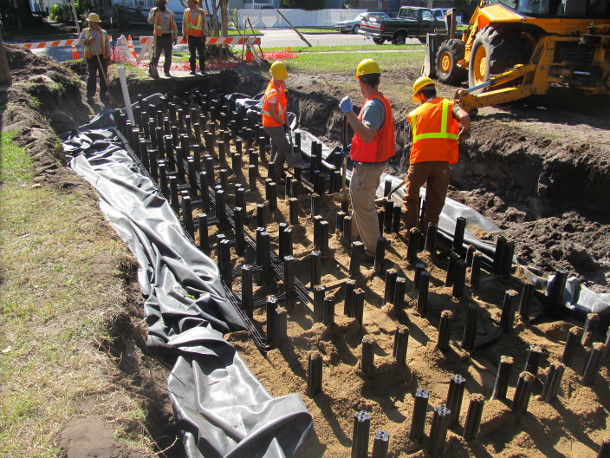
We are often asked for research results documenting the measurable benefits of using Silva Cells to manage stormwater on site, so we are thrilled to announce that two Silva Cell systems were installed for this purpose during the summer of 2012 in Wilmington, NC. They are being monitored by an excellent research team at Dr. William Hunt’s lab in Raleigh, NC, including Ryan Winston, Jonathan Page, and of course Bill Hunt himself.
If you haven’t been reading our blog for long, let me give a brief summary of how this works: the Silva Cells themselves do not manage stormwater, they just provide structural support so that the soil, the tree growing in the soil, and microbes on the tree roots and in the soil – which do all the work treating stormwater – are protected from compaction. (Compaction, which eliminates the macro-pore spaces in soil, is one of the main reasons traditional trees and tree basins are not effective at stormwater management).
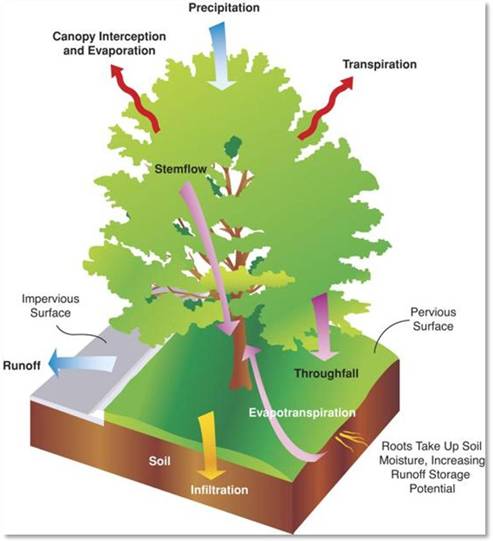
Xiao, Q.; McPherson, E.G.; Ustin, S.L.; Grismer, M.E. 2000. A new approach to modeling tree rainfall interception. Journal of Geographical Research Atmospheres 105: 29173-29188.
The Silva Cell system provides stormwater benefits in many ways. The three primary ones are:
1) Lightly compacted soil stores and cleans runoff
2) The tree intercepts rain falling on it
3) The tree uses much of the water stored in the soil
(See my earlier blog posts on the stormwater quality benefits of bioretention and trees and the stormwater quantity and rate control benefits of trees in uncomacted soil for more on mechanisms through which trees provide stormwater benefits).
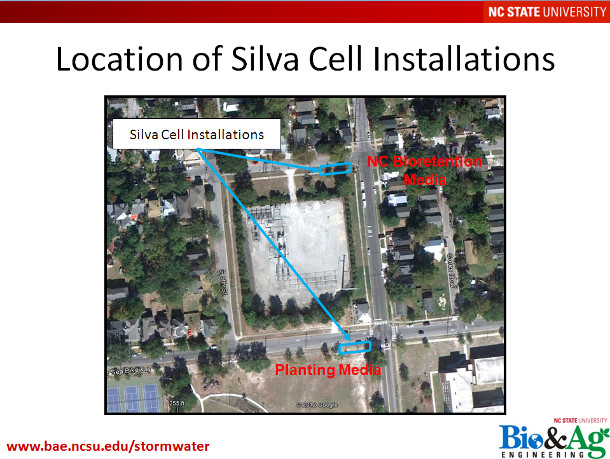
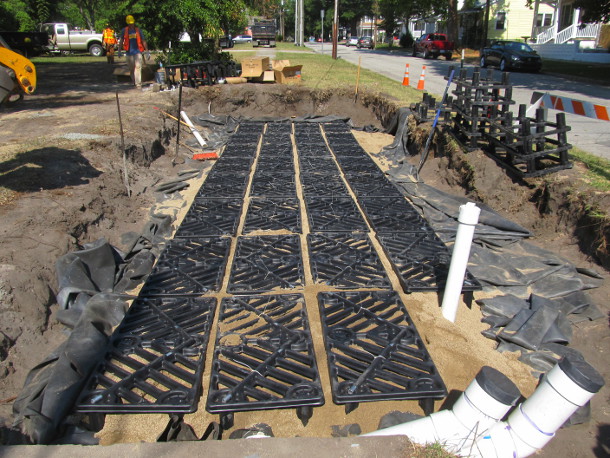
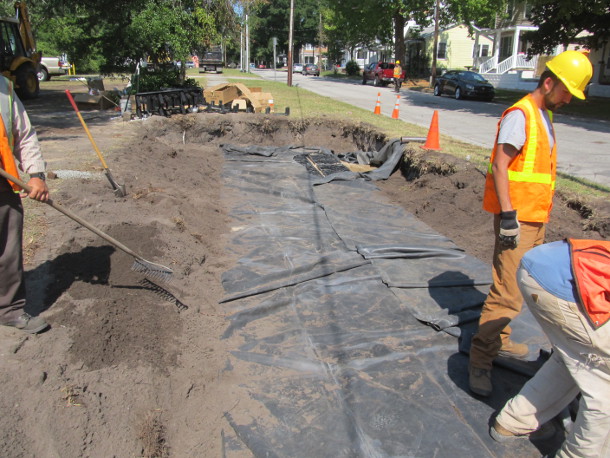
This Wilmington experiment is measuring the stormwater benefits provided by the uncompacted soil only. Here is an overview of the study:
- Two nearly identical Silva Cell systems were installed on two adjacent residential streets in Wilmington, NC.
- The variable between the two systems is the soil: one site was planted with a standard tree planting growing medium, the other with the North Carolina bioretention medium. The main differences between the two soil mixes are that the standard tree planting medium has more organic matter and fine particles.
- [North Carolina Bioretention Media: 85-88% sand, 8-12% clay and silt by volume, 3% organic matter by weight // Standard Tree Planting Media: 70% sand, 5% gravel, and 25% silt and clay by volume, 6 % organic matter by weight]
- Each system contains approximately 700 cubic feet of soil in a two cell deep Silva Cell system (68 Silva Cell frames, 34 decks).
- Both systems are lined with an impervious pond liner. This was installed to get as realistic/conservative data as we could because, (1) the soils at this site are very sandy (we didn’t want to over-represent the capacity of the system just because rain was infiltrating into exceptionally sandy soil), and (2) some of the area above the Silva Cells is turf (pervious), so wrapping the Cells in liner prevents rain that falls on the turf above the cells from entering the Silva Cell system.
- Runoff from the street is directed into the systems via a catch basin with a sump into a distribution pipe into the Silva Cell systems (see A on the image below)
- Underdrains with upturned elbows slow water and then direct runoff, if any, into the City’s existing storm sewer system (see B on the image below).
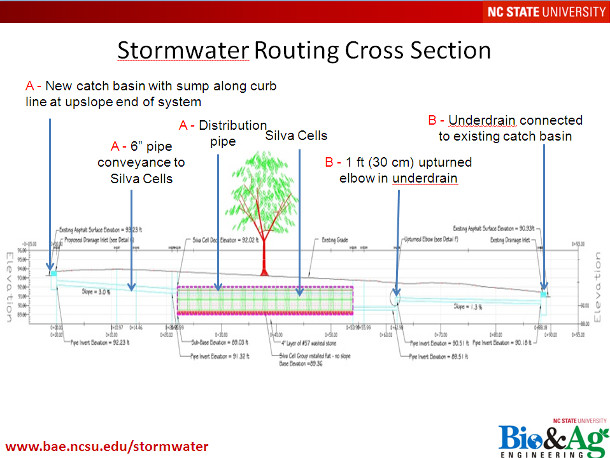
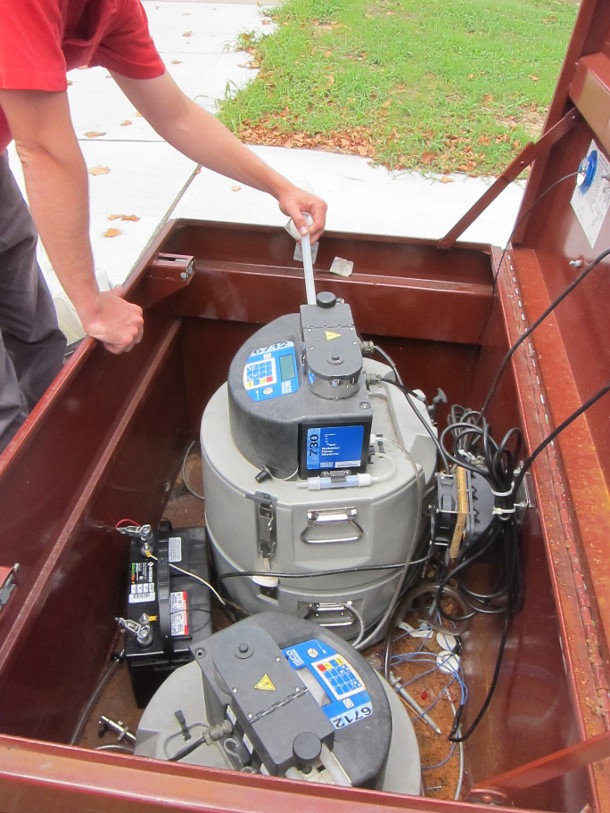
Control monitoring equipment
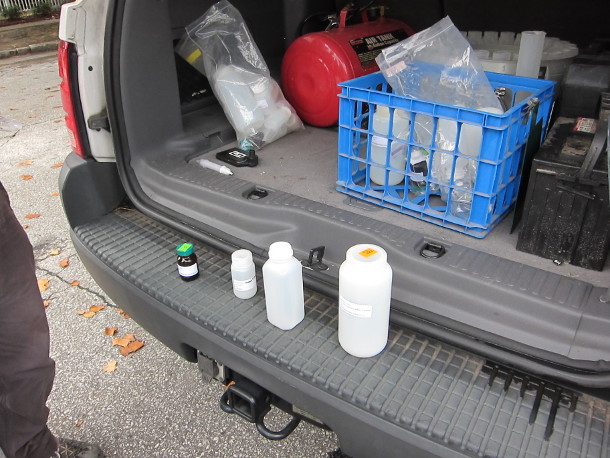
Pollutant testing bottles
The monitored parameters for this study are:
- Inflow and outflow volumes and rates
- nitrate-nitrite nitrogen (NO2-3-N)
- total ammoniacal nitrogen (TAN)
- total Kjeldahl nitrogen (TKN)
- total nitrogen (TN)
- orthophosphate
- total phosphorus (TP)
- total suspended solids (TSS)
- the heavy metals zinc (Zn), copper (Cu), and lead (Pb)
Monitoring began in August 2012, and the equipment all seems to be working as planned! In the first few storms measured, the systems did retain some of the stormwater, and water coming out of the outlet was fairly clean. Runoff flowing into the system was not that dirty in the first place, so we did not observe a large percent removal of pollutants. The system did not add nutrients to the outflow.
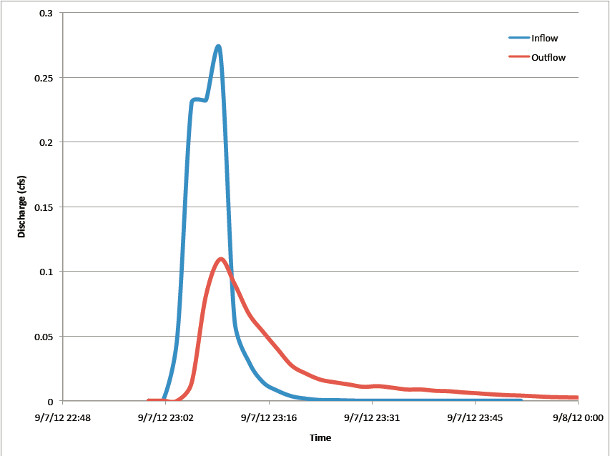
This hydrograph demonstrates the drop-off between inflow and outflow of water through the Silva Cell system over time.
The figure below shows the peak discharge rate reduction in the outflow pipe during the first storm. Dr. Hunt and his team will need to monitor 15 – 20 total storm events before results are statistically significant and they can make final conclusions about the performance of the system.
When I asked Ryan Winston what they expect to find at the conclusion of the study, he responded: “to prove to folks in North Carolina that this system can be used to treat stormwater in an ultra urban environment and spark more people to use these not only for tree benefits but also for stormwater benefits, and to see how they compare to other bioretention practices.”
Stay tuned for periodic updates throughout this coming year!






Leave Your Comment